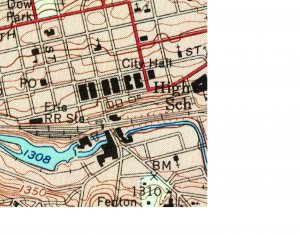James Olson
Member
I've read the forum FAQs & etc., searched older threads, and am uncomfortable asking for help without, first, giving it for several weeks/months but I don't have any experience. Plz. excuse any breach of protocol any faux pas committed.
- I didn't see any similar thread or Sticky; nor did I see the same questions posed elsewhere
- For several weeks I've been gathering information but haven't found the answers to the following questions, which seem should be fairly simple:
Re: LDEs
1) What Division/Branch of the Erie-Lackawanna (EL) served Jamestown, NY (Chautauqua County)?
2) Would this be the same Division/Branch designation under which one would look for the Erie RR Interstate Commerce Commission (ICC) valuation maps (of 1920)?
3) Are the valuation maps topographical? Has anyone used them to create Layout Design Elements (LDE).
Re: DCC
4) It seems most books about Digital Command Control (DCC) were written several years ago. Has the tech curve made any/some/most of these outdated? Any suggestions?
Re: Realistically Modeling Prototype Operations
[BTW, I have an interest in modeling the Erie-Lackawanna (EL) circa 1963; focusing on it's service in Chautauqua Co. (NY)....I know I'll have to fudge the date a little earlier for a lot of the siding and branch activity.]
5) I have a basic understanding about *what* is done (on the layout) but not *how* it's done (as far as how to sort cars, make cuts, performing siding drop-offs/pick-ups, etc.) I'm not sure how to design a layout of LDEs in which to make it work. I see mixed reviews of books on the subject. Any suggestions?
6) Ideally, I'd love to have an historical basis for my layout's operation (frequency of type of loads, etc.) but have no clue if this information is possible to obtain. Again, any suggestions or examples of what others have done to approximate reality?
Re: In General
7) Does it sound like I'm asking some of the right questions?
8) What do you think I'm not asking but, maybe, should....if anything?
Again, I'm sorry to have my first post here be asking for something instead of contributing something....I'll make it up, later.
- I didn't see any similar thread or Sticky; nor did I see the same questions posed elsewhere
- For several weeks I've been gathering information but haven't found the answers to the following questions, which seem should be fairly simple:
Re: LDEs
1) What Division/Branch of the Erie-Lackawanna (EL) served Jamestown, NY (Chautauqua County)?
2) Would this be the same Division/Branch designation under which one would look for the Erie RR Interstate Commerce Commission (ICC) valuation maps (of 1920)?
3) Are the valuation maps topographical? Has anyone used them to create Layout Design Elements (LDE).
Re: DCC
4) It seems most books about Digital Command Control (DCC) were written several years ago. Has the tech curve made any/some/most of these outdated? Any suggestions?
Re: Realistically Modeling Prototype Operations
[BTW, I have an interest in modeling the Erie-Lackawanna (EL) circa 1963; focusing on it's service in Chautauqua Co. (NY)....I know I'll have to fudge the date a little earlier for a lot of the siding and branch activity.]
5) I have a basic understanding about *what* is done (on the layout) but not *how* it's done (as far as how to sort cars, make cuts, performing siding drop-offs/pick-ups, etc.) I'm not sure how to design a layout of LDEs in which to make it work. I see mixed reviews of books on the subject. Any suggestions?
6) Ideally, I'd love to have an historical basis for my layout's operation (frequency of type of loads, etc.) but have no clue if this information is possible to obtain. Again, any suggestions or examples of what others have done to approximate reality?
Re: In General
7) Does it sound like I'm asking some of the right questions?
8) What do you think I'm not asking but, maybe, should....if anything?
Again, I'm sorry to have my first post here be asking for something instead of contributing something....I'll make it up, later.


